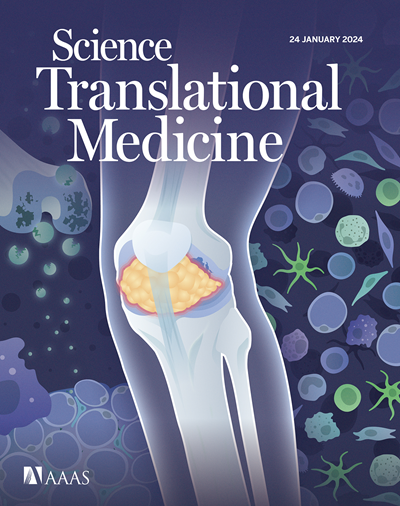Targeting SIRT2 induces MLH1 deficiency and boosts antitumor immunity in preclinical colorectal cancer models
IF 14.6
1区 医学
Q1 CELL BIOLOGY
引用次数: 0
Abstract
Low tumor mutation burden and an immunosuppressive tumor microenvironment (TME) of colorectal cancers (CRCs) contribute to resistance to immune-checkpoint inhibitors in patients. Understanding the mechanisms of cancer immune evasion will be helpful to develop new therapeutic strategies. Here, leveraging mass spectrometry–based proteomic profiling data and clinical validation, we identified that low sirtuin 2 (SIRT2) expression was associated with improved prognosis and an immune-active TME in CRC. Specifically, genetic knockdown or pharmacological inhibition of SIRT2 resulted in enhanced infiltration and cytotoxicity of CD8+ T cells, leading to tumor regression across multiple CRC mouse models and patient-derived organoids. Further in vitro experimental analysis demonstrated that SIRT2 interacted with and deacetylated MutL protein homolog 1 (MLH1) at Lys402/443/461, thereby preventing MLH1 ubiquitination and degradation. SIRT2 knockdown or inhibition down-regulated MLH1, increasing DNA damage and activating the cyclic GMP-AMP synthase–stimulator of interferon genes (cGAS-STING) pathway. In addition, both in vivo and in vitro experiments indicated that SIRT2 inhibition stimulated the production of tumor neoantigens and enhanced major histocompatibility complex class I (MHC-I) expression, reprogramming the TME toward an immune-active status and inducing long-lasting immune memory. Last, a combination strategy using SIRT2 inhibitor 2-cyano-3-[5-(2,5-dichlorophenyl)-2-furanyl]-N-5-quinolinyl-2-propenamide (AGK2) and anti–programmed cell death protein–1 (PD-1) therapy enhanced immune response, making tumors susceptible to immunotherapy and driving substantial tumor regression in vivo. Our study uncovers a role of SIRT2 in reprogramming TME and underscores the potential of targeting SIRT2 to sensitize CRC to immunotherapy.
靶向SIRT2诱导MLH1缺失,增强临床前结直肠癌模型的抗肿瘤免疫
结直肠癌(crc)的低肿瘤突变负担和免疫抑制肿瘤微环境(TME)有助于患者对免疫检查点抑制剂的耐药性。了解癌症免疫逃避的机制将有助于开发新的治疗策略。在这里,利用基于质谱的蛋白质组学分析数据和临床验证,我们发现SIRT2的低表达与CRC预后改善和免疫活性TME相关。具体而言,基因敲低或药物抑制SIRT2导致CD8 + T细胞浸润和细胞毒性增强,导致多种CRC小鼠模型和患者来源的类器官肿瘤消退。进一步的体外实验分析表明,SIRT2与MutL蛋白同源物1 (MLH1)在Lys 402/443/461位点相互作用并使其去乙酰化,从而阻止MLH1泛素化和降解。SIRT2敲低或抑制下调MLH1,增加DNA损伤,激活干扰素基因环GMP-AMP合成酶刺激因子(cGAS-STING)通路。此外,体内和体外实验均表明,SIRT2抑制刺激肿瘤新抗原的产生,增强主要组织相容性复合体I类(MHC-I)的表达,使TME重新编程,进入免疫活性状态,并诱导持久的免疫记忆。最后,使用SIRT2抑制剂2-氰-3-[5-(2,5-二氯苯基)-2-呋喃基]- n -5-喹啉基-2-丙烯酰胺(AGK2)和抗程序性细胞死亡蛋白-1 (PD-1)治疗的联合策略增强了免疫反应,使肿瘤对免疫治疗敏感,并在体内推动肿瘤的实质性消退。我们的研究揭示了SIRT2在TME重编程中的作用,并强调了靶向SIRT2使CRC对免疫治疗敏感的潜力。
本文章由计算机程序翻译,如有差异,请以英文原文为准。
求助全文
约1分钟内获得全文
求助全文
来源期刊

Science Translational Medicine
CELL BIOLOGY-MEDICINE, RESEARCH & EXPERIMENTAL
CiteScore
26.70
自引率
1.20%
发文量
309
审稿时长
1.7 months
期刊介绍:
Science Translational Medicine is an online journal that focuses on publishing research at the intersection of science, engineering, and medicine. The goal of the journal is to promote human health by providing a platform for researchers from various disciplines to communicate their latest advancements in biomedical, translational, and clinical research.
The journal aims to address the slow translation of scientific knowledge into effective treatments and health measures. It publishes articles that fill the knowledge gaps between preclinical research and medical applications, with a focus on accelerating the translation of knowledge into new ways of preventing, diagnosing, and treating human diseases.
The scope of Science Translational Medicine includes various areas such as cardiovascular disease, immunology/vaccines, metabolism/diabetes/obesity, neuroscience/neurology/psychiatry, cancer, infectious diseases, policy, behavior, bioengineering, chemical genomics/drug discovery, imaging, applied physical sciences, medical nanotechnology, drug delivery, biomarkers, gene therapy/regenerative medicine, toxicology and pharmacokinetics, data mining, cell culture, animal and human studies, medical informatics, and other interdisciplinary approaches to medicine.
The target audience of the journal includes researchers and management in academia, government, and the biotechnology and pharmaceutical industries. It is also relevant to physician scientists, regulators, policy makers, investors, business developers, and funding agencies.
 求助内容:
求助内容: 应助结果提醒方式:
应助结果提醒方式:


